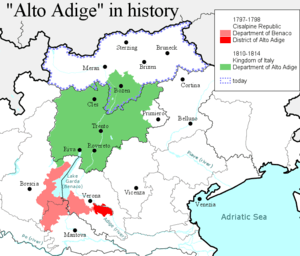Department of Alto Adige
| Dipartimento dell'Alto Adige | |||||
| Department of Kingdom of Italy (Napoleonic) | |||||
| |||||
 | |||||
| Capital | Trento | ||||
| History | |||||
| • | Established | 1810 | |||
| • | Disestablished | 1814 | |||
The Department of Alto Adige (Italian and official Dipartimento dell'Alto Adige, French: département du Haut-Adige, translated into English Department of Upper Adige[1]) was a northern department of the Napoleonic Kingdom of Italy. The name had been used for a district of the Cisalpine Republic. Its name, in typical Napoleonic fashion of naming departments after geographic features, derived from the river Adige (Etsch) which flowed through it.
Neither the Cisalpine district nor the department of the Kingdom of Italy correspond precisely to the modern Italian province of Alto Adige (also known officially as "Alto Adige-South Tyrol"), although there is some geographical overlap.
History
Cisalpine Republic
Under the Cisalpine Republic a district of Alto Adige (Distretto dell'Alto Adige) was created as a part of the short-lived "Department of Benaco". The District of Alto Adige included some municipalities of today's province of Verona.[2][3] The Department of Benaco, which was created in 1797, was disbanded in 1798 and with it the District of Alto Adige after a structural reorganization of the Napoleon's Italian republic.
Kingdom of Italy
After the partition of the County of Tyrol between Bavaria and the Kingdom of Italy on 9 June 1810 by Napoleon Bonaparte, the new department of Alto Adige was created. It comprised parts of today's province of South Tyrol (the city of Bolzano, the district of Überetsch-Unterland, a relevant part of Salten-Schlern and a small part of Burggrafenamt),[4][5] the largest part of today's province of Trentino and some communes in the provinces of Vicenza and Brescia.
Its capital was Trent and the administrative language Italian, but the German-speaking areas temporarily adopted bilingualism in the public notices and used German in city government. The department was known in German as "Ober-Etsch".[6]
The department included the area around Bolzano, that had a population mostly romance speaking (Italians and Ladins) while the other areas of the former South Tyrol were left united to Bavaria because mostly German speaking.
The department was disbanded after the defeat of Napoleon in 1814. Its territory is divided over the Italian autonomous provinces of Trentino and South Tyrol.

Reuse of name
The name Alto Adige had no historical antecedent about the region it denoted, but merely described the geographic area of the upper reaches of the Adige river. This was something that was commonly done during the Napoleonic period when naming departments, ignoring any historical names or connotations but using geographical references. The name was dropped after the end of the Napoleonic period, but was used by the Italian irredentists in the mid 1800s.
The term "Alto Adige" was later used as the Italian name of the province of Bolzano by the fascist Ettore Tolomei in his Italianization campaign. He used the words "Alto Adige" as a historical connection to the Napoleon's geopolitical transformation of the Italian peninsula.[7] In 1918 what was used to be officially called "southern Tyrol" was united after the end of World War I to Italy; but the term "Alto Adige" was applied instead of the Austrian-proposed "Italian Tyrol" (Tirolo Italiano) or "Tridentine Tyrol" (Tirolo tridentino). "Alto Adige" was made official by the fascist regime in 1923.
References
- ↑ The history of the reign of George III, p. 290, at Google Books
- ↑ Cisalpine Republic (1797). Raccolta delle leggi, proclami, ordini ed avvisi, Vol 4 (in Italian). Milan: Luigi Viladini. p. 201.
- ↑ Cisalpine Republic (1798). Raccolta delle leggi, proclami, ordini ed avvisi, Vol 5 (in Italian). Milan: Luigi Viladini. p. 184.
- ↑ Province of Trento, trentinocultura, IL TIROLO NEL PERIODO NAPOLEONICO, Tirol at the time of Napoleon
- ↑ Erich Egg, Meinrad Pizzinini, Beiträge zur Geschichte Tirols: Festgabe des Landes Tirol zum 11. Österr. Historikertag in Innsbruck vom 5. bis 8. Okt. 1971, Land Tirol, Kulturabt. im Amt d. Tiroler Landesregierung, 1971, page 148
- ↑ Bertuch, Friedrich Justin (1813). Allgemeine geographische Ephemeriden, Vol. 40 (in German). Weimar: Verlage des landes-Industrie comptoirs. p. 168.
- ↑ Alto Adige under Napoleon
Further reading
- Reinhard Stauber, Der Zentralstaat an seinen Grenzen. Administrative Integration, Herrschaftswechsel und politische Kultur im südlichen Alpenraum 1750–1820 (Schriftenreihe der Historischen Kommission der Bayerischen Akademie der Wissenschaften, 64), Göttingen, Vandenhoeck & Ruprecht, 2001. ISBN 978-3-525-36057-6